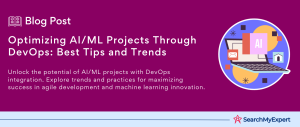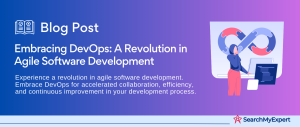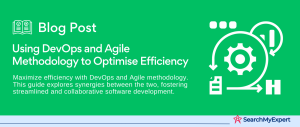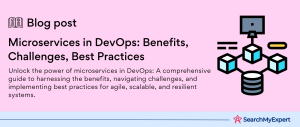Understanding DevOps – The Synergy of Development and Operations
DevOps stands as a pivotal approach in the world of software development, representing a significant shift in how development and operations teams collaborate to enhance software delivery. At its core, DevOps embodies a fusion of philosophies, practices, and tools that aim to bridge the often siloed roles of software development (Dev) and IT operations (Ops). The fundamental premise of DevOps is to foster a culture of collaboration, automation, and continuous improvement, each playing a crucial role in achieving more efficient, reliable, and faster software deployment.
Collaboration: The Heart of DevOps
Collaboration is the cornerstone of the DevOps philosophy. In traditional models, development and operations teams often work in isolation, leading to a lack of communication and understanding. DevOps breaks down these barriers, fostering a culture where both teams work closely throughout the entire software development lifecycle. This synergy encourages shared responsibilities, open communication, and a unified approach to problem-solving. By working together, teams can identify and address issues more quickly, leading to a more streamlined and effective development process.
Automation: The Engine of Efficiency
Automation in DevOps is not just a tool; it’s an integral component that drives efficiency and reliability. Through automation, repetitive and manual tasks are minimized, allowing teams to focus on more strategic and creative aspects of development. Automation encompasses various stages of the software delivery process, including code integration, testing, deployment, and infrastructure management. By automating these processes, DevOps enables faster and more consistent deployments, reduces the likelihood of errors, and ensures that the software is always in a deployable state.
Continuous Improvement: The Path to Excellence
Continuous improvement, a key principle in DevOps, revolves around the idea of ongoing development and refinement. It involves regularly assessing and enhancing processes, tools, and methodologies to boost efficiency, quality, and performance. This aspect of DevOps is often realized through continuous integration and continuous delivery (CI/CD) practices, where code changes are automatically tested and deployed, ensuring a constant flow of improvements to the software. Continuous feedback loops are also vital, allowing teams to learn from successes and failures and apply these learnings to future projects.
Continuous Integration and Delivery (CI/CD): Streamlining Software Deployment
The CI/CD pipeline is an essential component of the DevOps methodology, designed to improve the efficiency and quality of software development and deployment. CI/CD stands for Continuous Integration and Continuous Delivery (or Continuous Deployment). This system automates the integration of code changes from multiple contributors, tests the new code, and then automatically deploys it to production. The CI/CD pipeline is a crucial part of modern software development practices, directly addressing the challenges of integrating and delivering software in a fast-paced environment.
Understanding the CI/CD Pipeline
- Automated Code Integration:
The first phase, Continuous Integration (CI), involves automatically integrating code changes into a shared repository. Developers frequently merge their changes, often multiple times a day, and each integration is automatically tested to detect issues early. - Automated Testing: Once the code is integrated, it undergoes a series of automated tests. These can range from unit tests, integration tests, to functional and performance tests. The goal is to ensure that the new code does not break or degrade the existing system.
- Automated Delivery: Continuous Delivery (CD) takes over post-testing. In this phase, the tested code is automatically deployed to a staging or production environment. Continuous Deployment may extend this by deploying every change that passes the testing phase directly to production.
Benefits of CI/CD
- Faster Releases:
By automating integration, testing, and delivery, CI/CD significantly reduces the time to market for new features and fixes. This agility allows organizations to respond more swiftly to market demands. - Fewer Errors:
Automated testing ensures that errors and bugs are caught early in the development cycle, reducing the likelihood of introducing defects into production. - Improved Quality: Continuous testing and delivery ensure that the product is always in a deployable state, enhancing the overall quality of the software.
Tools and Best Practices for Implementing CI/CD
Popular CI/CD Tools:
- Jenkins: An open-source automation server that offers plugins for building, deploying, and automating any project.
- GitLab CI/CD: Provides a well-integrated CI/CD service with its own repository management system.
- CircleCI:
Known for its flexibility and integration capabilities with various platforms. - Travis CI: A cloud-based service that seamlessly integrates with GitHub projects.
Best Practices:
- Maintain a Robust Testing Framework:
Ensure that your CI/CD pipeline includes a comprehensive set of automated tests to catch bugs early. - Version Control Integration:
Integrate your CI/CD pipeline with version control systems like Git to track and manage changes efficiently. - Frequent, Small Commits:
Encourage developers to make small, frequent commits. This practice makes integrating and testing changes easier and more manageable. - Monitor and Optimize:
Continuously monitor the pipeline’s performance and seek opportunities to optimize processes for speed and efficiency.
Automation is King: The Driving Force of Efficient DevOps
In the DevOps realm, automation is not just a luxury; it’s a necessity. Automation plays a pivotal role in enhancing efficiency, consistency, and reliability across all stages of software development and deployment. By reducing manual tasks, automation frees up teams to focus on more strategic and innovative activities, thus accelerating the delivery process and minimizing the risk of human error.
Key Areas for Automation in DevOps
- Infrastructure Provisioning: Automating the setup and maintenance of servers and other infrastructure components ensures a consistent and repeatable environment. This practice, often referred to as “Infrastructure as Code” (IaC), enables quick and efficient provisioning of infrastructure through code.
- Configuration Management:
Configuration management tools automate the process of controlling and tracking changes to the software configuration, ensuring that systems are consistently maintained in a desired state. This area includes everything from operating systems settings to software installations and network configurations. - Automated Testing: In the DevOps approach, testing is integral and must be automated to keep up with the pace of continuous integration and delivery. Automated testing frameworks execute a battery of tests to validate code changes, ensuring that new features don’t break existing functionality.
- Automated Deployments: Automation in deployments ensures that new versions of applications are smoothly and consistently released into production or staging environments. This reduces the risks associated with manual deployment processes and speeds up the time it takes to get new features to users.
Examples of Automation Tools and Success Stories
- Terraform:
An IaC tool that enables users to define and provision infrastructure using a simple, declarative language. Terraform’s ability to manage cloud services and custom in-house solutions makes it a versatile choice for infrastructure automation. - Ansible: A powerful configuration management tool, Ansible uses simple YAML syntax to automate complex multi-tier IT application environments. Its agentless architecture and human-readable language have made it a popular choice among DevOps teams.
- Selenium: A staple in automated testing, Selenium allows for automation of web browsers, enabling testers to create robust, browser-based regression automation suites and tests.
- Docker:
Docker has revolutionized deployments by enabling applications to be packaged into containers—standardized executable components combining application source code with the operating system (OS) libraries and dependencies required to run that code in any environment.
Success Stories
- A notable success story is that of Netflix, which has extensively utilized automation in its DevOps practices. By implementing automated canary analysis, Netflix ensures that new deployments are gradually introduced to users, automatically rolling back if anomalies are detected.
- Etsy, the global online marketplace, is another example. By automating their deployment process and implementing continuous integration, Etsy has been able to significantly reduce the time and effort required to release new features, leading to a more responsive and agile development cycle.
Infrastructure as Code (IaC): Revolutionizing Infrastructure Management
Infrastructure as Code (IaC) represents a transformative shift in how IT infrastructure is managed and provisioned. By treating infrastructure – servers, networks, virtual machines, and more – as code, IaC allows for the automation and standardization of infrastructure deployment and management. This approach enables DevOps teams to handle infrastructure with the same practices and tools used in software development, such as version control, collaboration, and continuous integration.
Benefits of Infrastructure as Code
- Consistency: IaC ensures a consistent environment setup. Defining infrastructure through code, it eliminates discrepancies that can arise from manual configurations, making it easier to manage and scale infrastructure.
- Repeatability: IaC allows for the easy replication of environments. This repeatability is crucial for reducing errors in deployment, and ensuring that development, testing, and production environments are identical.
- Version Control:
With infrastructure defined as code, it can be versioned and tracked using the same version control systems used for application code. This approach allows for tracking changes, auditing, and rolling back to previous configurations if needed.
Popular IaC Tools and Methodologies
- Terraform: Terraform, developed by HashiCorp, is an open-source IaC tool that allows for the creation, modification, and versioning of infrastructure safely and efficiently. Terraform uses a declarative configuration language to describe the desired state of infrastructure. It supports multiple cloud providers and services, making it a versatile tool for multi-cloud environments.
- AWS CloudFormation: Specifically designed for AWS (Amazon Web Services), CloudFormation provides a common language to describe and provision all the infrastructure resources in AWS cloud environments. It allows users to model their entire AWS infrastructure in a text file, enabling them to create and manage a collection of related AWS resources.
- Methodologies:
- Declarative vs. Imperative Approaches: IaC can be implemented using declarative (specifying the desired state) or imperative (specifying the steps to achieve the desired state) approaches. Tools like Terraform use a declarative model, focusing on the end state, whereas tools like Ansible, which can also be used for IaC, follow an imperative approach.
- Idempotence: An important concept in IaC, idempotence refers to the property of certain operations in computing that can be applied multiple times without changing the result beyond the initial application. This concept is essential in IaC to ensure that re-running code doesn’t cause failures or unintended changes.
Monitoring and Observability: The Pillars of System Health and Performance
In the realm of DevOps, monitoring, and observability are critical for maintaining the health and efficiency of applications and infrastructure. These practices provide teams with the insights needed to ensure systems run smoothly and reliably, ultimately leading to a better end-user experience.
The Importance of Monitoring
- Continuous Tracking: Monitoring involves the continuous tracking of application and infrastructure performance. It helps in detecting and alerting on anomalies, performance bottlenecks, and system failures, enabling quick response and resolution.
- Key Metrics: Effective monitoring focuses on key metrics such as system uptime, response times, resource utilization (like CPU and memory usage), and error rates. These metrics provide a real-time overview of system health.
- Proactive Problem-Solving: Regular monitoring allows teams to proactively address issues before they escalate into more significant problems, reducing downtime and improving overall system reliability.
Introducing Observability
- Deep System Understanding:
Observability goes beyond monitoring by offering deeper insights into how systems are performing. It’s about understanding the internal state of a system by examining its outputs – logs, metrics, and traces. - Holistic View:
Observability provides a holistic view of the system, correlating data across various sources to understand complex system behaviors and interactions. - Predictive Insights: It enables predictive analysis, helping teams to anticipate issues and trends, and make informed decisions based on comprehensive data analysis.
Tools and Techniques for Monitoring and Observability
Monitoring Tools:
- Prometheus: An open-source monitoring solution that provides powerful data modeling, querying, and alerting capabilities.
- Nagios: A widely-used monitoring system that offers monitoring and alerting services for servers, switches, applications, and services.
- Datadog: A cloud-based monitoring service that provides extensive monitoring capabilities across cloud services, servers, databases, tools, and services.
Logging Tools:
- ELK Stack (Elasticsearch, Logstash, Kibana):
A popular choice for logging, allowing for powerful data ingestion (Logstash), storage (Elasticsearch), and visualization (Kibana). - Splunk:
Offers robust log analysis and visualization, widely used for exploring and visualizing large data sets.
Tracing Techniques:
- Distributed Tracing:
Essential for microservices architectures, tools like Jaeger and Zipkin provide distributed tracing to track requests as they flow through various services. - APM Tools: Application Performance Management (APM) tools like New Relic and Dynatrace offer tracing capabilities along with performance monitoring, giving insights into how applications are performing.
Building a Collaborative Culture: The Human Element in DevOps
A successful DevOps implementation hinges not just on tools and technologies, but crucially on the human element – the culture of collaboration between development (Dev) and operations (Ops) teams. Fostering a healthy DevOps culture is essential for breaking down silos, enhancing team synergy, and achieving the ultimate goal of faster and more efficient software delivery.
The Importance of Communication and Collaboration
- Breaking Down Silos: Traditionally, development and operations teams have operated in silos, often leading to miscommunications and delays. DevOps emphasizes breaking down these barriers and encouraging open communication and collaboration.
- Shared Goals: In a DevOps culture, both teams share the responsibility for the software’s performance and stability, aligning their goals towards a common objective.
- Faster Issue Resolution: Collaborative teams can respond to and resolve issues more quickly, as both the development and operations perspectives are considered in problem-solving.
Practices for Fostering a Healthy DevOps Culture
- Shared Ownership:
This approach involves both teams taking collective responsibility for the entire lifecycle of the product, from design to deployment and ongoing support. It creates a sense of unity and purpose, driving teams to work together more effectively. - Blameless Post-Mortems:
When things go wrong, blameless post-mortems focus on understanding the root cause of the problem without assigning blame. This practice encourages a learning culture, where teams can openly discuss failures and learn from them without fear of retribution. - Knowledge Sharing: Regular knowledge-sharing sessions, like workshops, joint training programs, and cross-team meetings, help bridge the gap between Dev and Ops. These sessions promote a deeper understanding of each team’s challenges and workflows, fostering empathy and collaboration.
The Role of Automation in Enabling Collaboration
- Removing Manual Tasks: Automation of repetitive tasks frees up time for teams to focus on more strategic work. This reduction in manual workload allows teams to collaborate more on creative problem-solving and innovation.
- Consistent Environments:
Automation tools ensure consistent environments across development, testing, and production. This consistency helps reduce the “it works on my machine” syndrome, a common source of friction between Dev and Ops teams. - Faster Feedback Loops:
Automated testing and continuous integration tools provide immediate feedback on changes, allowing teams to work together more dynamically and iteratively.
Continuous Improvement and Learning: The Heartbeat of DevOps Progress
In the dynamic world of DevOps, continuous improvement and learning are not just practices; they are foundational philosophies. DevOps is inherently iterative, characterized by a cycle of experimenting, learning from successes and failures, and consistently evolving. This approach is crucial for adapting to changing technologies and market demands, ensuring that teams remain agile, efficient, and innovative.
The Iterative Nature of DevOps
- Experimenting:
DevOps encourages experimentation, fostering an environment where innovative ideas are tested, and new approaches are explored. This experimental mindset leads to creative solutions and technological advancements. - Learning from Failures:
In DevOps, failures are viewed as opportunities for growth. The emphasis is on analyzing missteps, understanding their root causes, and using these insights to improve future processes. - Constantly Improving: DevOps is a journey, not a destination. Teams are continually refining their practices, tools, and workflows to enhance efficiency, reduce errors, and improve the overall quality of software delivery.
Metrics for Measuring DevOps Success
- Lead Time: The time taken from code commit to code successfully running in production. Shorter lead times indicate a more efficient and responsive development process.
- Deployment Frequency:
The frequency with which new releases are deployed to production. Higher deployment frequencies are a hallmark of a mature DevOps practice, reflecting an ability to deliver new features and fixes rapidly. - Error Rate: The rate of failures in production. Monitoring the error rate is crucial for maintaining the quality and reliability of software. A lower error rate points to a robust testing and deployment process.
Encouraging Ongoing Learning and Adoption of New Tools
- Continuous Learning:
DevOps teams should be committed to continuous learning, staying abreast of the latest industry trends, tools, and best practices. This learning can be facilitated through workshops, conferences, webinars, and online courses. - Adoption of New Tools and Practices:
The technology landscape is continually evolving, and so are the tools and practices in DevOps. Teams should be open to experimenting with new technologies and incorporating them into their workflow to enhance their capabilities. - Feedback Loops:
Implementing effective feedback mechanisms, both from within the team and from end-users, is crucial for understanding the impact of changes and identifying areas for improvement.
Conclusion:
DevOps represents a paradigm shift in the world of software development and IT operations. It’s not just a set of practices; it’s a culture that emphasizes collaboration, automation, and continuous improvement. From the integration and delivery processes in CI/CD to the infrastructure management through IaC, each aspect of DevOps works synergistically to enhance efficiency, reduce error rates, and foster a proactive approach to problem-solving. Monitoring and observability ensure that systems are performing optimally, while the emphasis on a collaborative culture bridges gaps between teams, encouraging shared responsibility and open communication. Lastly, the spirit of continuous improvement and learning ensures that DevOps is an ever-evolving journey, adapting to new challenges and technologies. By embracing these principles, organizations can not only streamline their software development processes but also create a more agile, responsive, and innovative IT environment.
Elevate your IT agility with DevOps Service Companies.
Table of Contents
Toggle






